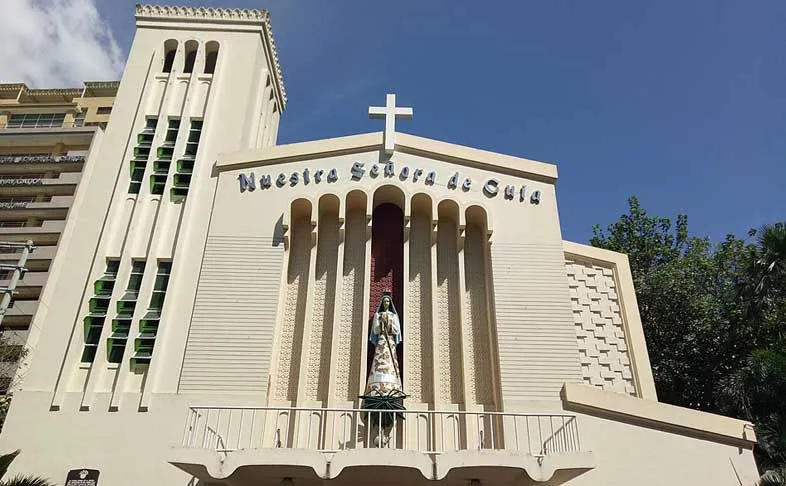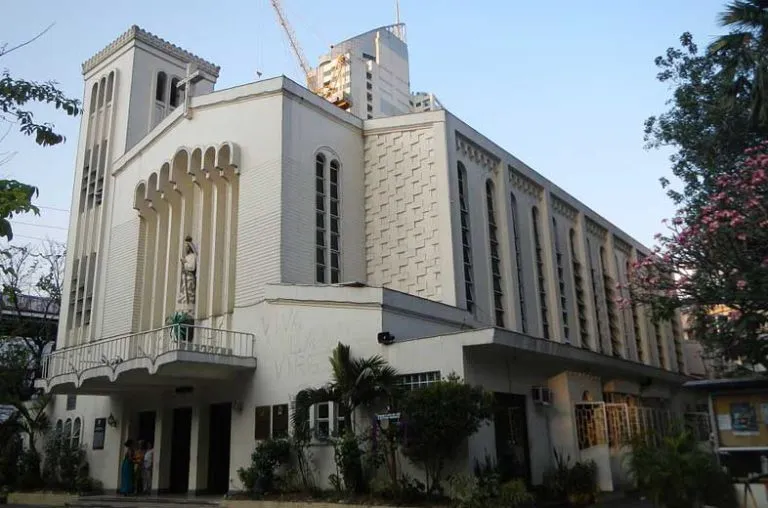
Introduction
The Archdiocesan Shrine of Our Lady of Guidance, also known as Ermita Shrine or Ermita Church (Spanish: La Ermita de Nuestra Señora de Guía) is a shrine located in the district of Ermita in the city of Manila, Philippines. The church is home to the Marian image of the Immaculate Concepcion known as Nuestra Señora de Guía, which is considered to be oldest in the Philippines, and in whose honor the church is officially named after and dedicated to.
Although the image may not look that old, the Ermita Shrine is already four century old. The church began as a rustic shrine made of bamboo, nipa, and molave wood that was built to house the image of Our Lady of Guidance. Miguel Lopez De Legazpi sent his troop to the Northern region of Luzon to conquer the place. The troop lead by Martín de Goiti arrived in Manila bay and one of the soldiers founded the first church in the area which is now known as Ermita to house the image of our lady.
The Church was damaged numerous times during Earthquakes and the image was actually transferred to Manila Cathedral and the image was returned to the church of Ermita after 156 years (the image was transferred to Cathedral in 1762 and was returned to a much stronger Stone church built in 1810 in 1918).
The church’s main altar with the original image of Nuestra Señora De Guia at the center. The church was once again utterly destroyed during the second World War and the image was saved from destruction and was temporarily kept in a private residence. The reconstruction began in 1947 and was completed in 1953 (the same year the image was returned).
The church has a very simple yet easily recognizable facade. Gracing the center of the facade is a statue depicting the image of Our Lady of Guidance.
Nuestra Señora De Guia or Our Lady of Guidance is venerated as the patroness of Seafarers (sea navigators and travelers). They said that the original image of the Lady was actually brought by Ferdinand Magellan in 1521 and was given as a gift to Rajah Humabon, whose realm included what is now Cebu City. The image was canonically crowned on Rizal Day, December 30, 1955.
History of Ermita Church, Manila
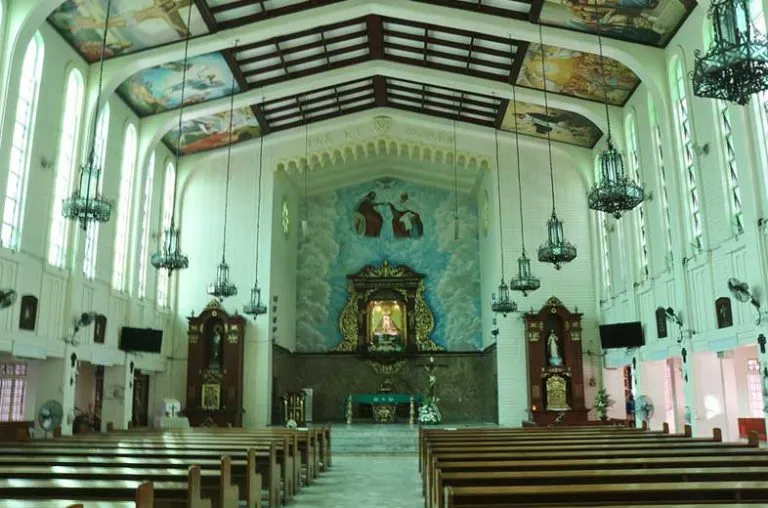
The church began as a rustic shrine made of bamboo, nipa, and molave wood that was built to house the image of Our Lady of Guidance in the area where it was found in 1571 by Spanish soldiers under Miguel López de Legazpi. The shrine eventually became a chapel built in 1606 as house for the image and was called La Hermita (“The Chapel” or “Hermitage” in English). The word also gave the name to the present district in Manila where the chapel is located.
The church was damaged many times due to earthquakes. In addition, the image had to be transferred to the Manila Cathedral for safekeeping during the British occupation of Manila in 1762–1764. A more permanent stone church was built in 1810; the image was returned to the church in 1918.
In 1945 near the end of World War II, the church was reduced to rubble during the Battle of Manila. However, the image was saved from destruction and was temporarily kept in a private residence. Work began for the reconstruction of the church in 1947 with a new design by architect Carlos A. Santos-Viola.
On March 28, 1949, attorney and future senator Jose W. Diokno married Carmen Icasiano at Ermita Church. Diokno was also baptized here on September 3, 1922, his godmother and second mother was Paz Wilson. By 1953, the reconstruction was completed and the image was returned to the new church.
On December 3, 2005, Manila Archbishop Most Rev. Gaudencio B. Cardinal Rosales, elevated the status of this church to an archdiocesan shrine.
Our Lady of Guidance
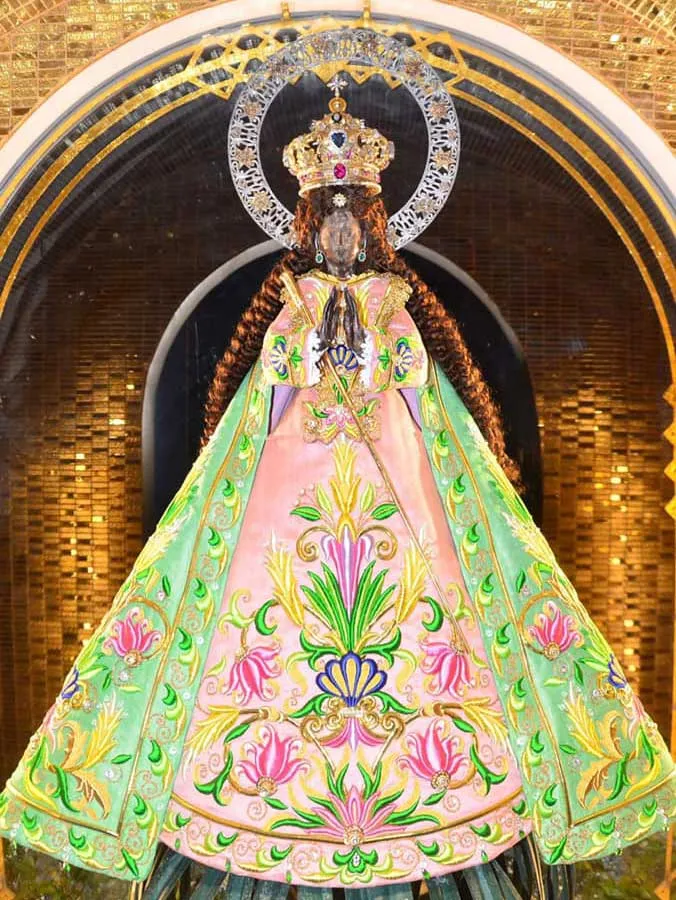
The Our Lady of Guidance (Spanish: Nuestra Señora de Guía) is a 16th-century image of the Blessed Virgin Mary depicted as the Immaculate Conception and widely venerated by Filipinos. The wooden Black Madonna is considered the oldest extant Marian statue in the Philippines.
Locally venerated as patroness of navigators and travelers, the image is enshrined at the Ermita Church in the city of Manila.
Due to its fragility and value, the original Marian image does not leave the premises of its inner sanctum except when the pontiff visits the country.[citation needed] A modern proxy image (called “Vicaria”) is used for exposed church services instead.
Made of indigenous molave (Vitex cofassus) wood, the statue stands about 50 centimetres (20 in) an is characterized by dark skin, Asiatic features, and long brunette hair. It is often dressed in both a manto and a stylized tapis, the indigenous wraparound skirt of Filipino women.
Among her regalia are a sceptre, a parure of jewels offered by Archbishop of Manila Rufino J. Cardinal Santos in 1960, and a gold crown bestowed by Pope Paul VI during his visit to Manila Cathedral on 16 May 1971.
According to the Anales de la Catedral de Manila, the crew of Miguel López de Legazpi discovered a group of natives in what is now Ermita along the eastern shores of Manila Bay worshiping a statue of a female figure. There are several theories of its origin, as an Animist-Tantrist Diwata, an East Asian statue due to her Chinese features, a Marian icon imported from nearby Portuguese Macau, or, due to its striking resemblance to the Santo Niño de Cebu, a relic of the 1521 Magellan expedition. This sacred statue had managed to survive the Islamic iconoclasm by the Sultanate of Brunei, a state that had invaded and colonised Manila.
While its original purpose is debated, the image was later identified by missionaries as the Virgin Mary. Local folklore recounts the Spaniards witnessing natives venerating the statue in a “pagan manner”, by placing it on a trunk surrounded by pandan plants. The pandan is a common food ingredient in the Indianised cultures of South and Southeast Asia to which it is endemic. The manner of worship of this Catholic icon is remembered in the placement of pandan leaves, real or imitation, surrounding the andas as one of its attributes.
History of Our Lady of Guidance
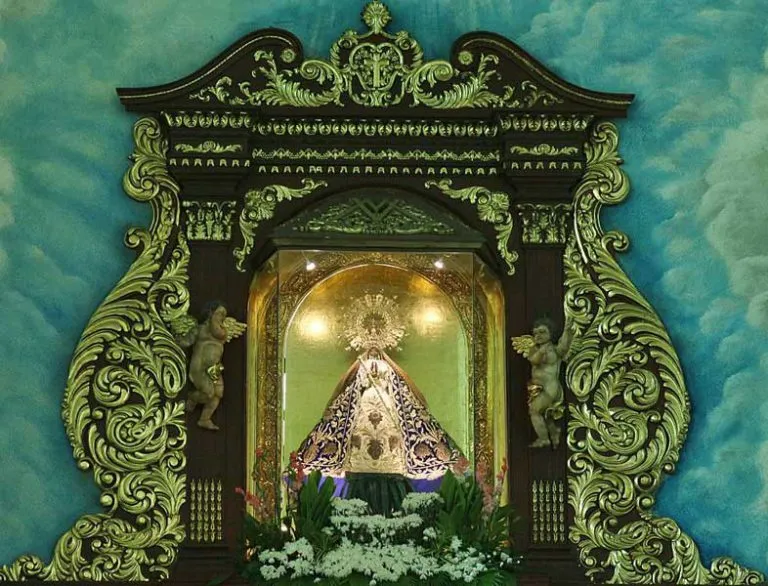
On 19 May 1571, the local sovereigns Sulayman III and Rajah Matanda ceded Kota Selurong (a client state of the Sultanate of Brunei) as well as the Kingdom of Tondo, to the Spanish Empire, with Miguel López de Legazpi, who had arrived from Mexico, consecrating the city to both Saint Pudentiana and Our Lady of Guidance.
In 1578, Philip II of Spain issued a royal decree invoking Our Lady of Guidance to be “sworn patroness” of Manila. The statue was first enshrined in Manila Cathedral inside the citadel of Intramuros until 1606, when the first shrine compound was built on the current site. Called La Hermita (“the Hermitage”) because of a Mexican hermit who lived in the area, the shrine was originally made of bamboo, nipa, and molave wood. It was later rebuilt in stone but suffered damaged in an earthquake in 1810.
The icon was first revered under the title of the Immaculate Conception, however, the Spanish explorers who first discovered her, together with the native Filipinos who witnessed their wishes and supplications granted before the icon, considered her as their mutual guide. When the image was later moved to Ermita shrine from Intramuros, the tower of the Ermita shrine emitted light at night or during storms. This light guided traveling ships and sailors in the darkness, and people named the icon “Our Lady of Guidance”.
In 1897, a novena booklet titled Novena o Pagsisiam sa Nuestra Señora de Guia (“Novena to Our Lady of Guidance”) was published by the Pontifical and Royal University of Santo Tomas in Manila. The text recounts the image’s origin story, where natives found it sitting on a trunk, and built a roof above it, and the surrounding pandan plants. The text goes on to condemn them for their polytheism, and mentions murder. The image initially had a feast day on 18 December, but the date was transferred to 19 May when a rainstorm struck Manila Cathedral in February 1771.
During the Second World War, the statue was saved by the parish priest of Ermita Church, Fr. Blas de Guernica, and a Justo N. López. They hid the statue in a niche of the church’s crypt a few weeks before the Allies liberated Manila in February 1945. After the battle, Fr. Rogelio Bedonia, along with a chaplain and four soldiers of the United States Army, went to the obliterated shrine, retrieved the icon, and brought it to a safer place. Until the construction of a temporary chapel, the icon stayed in a private house on Taft Avenue, in San Miguel de Mayumo and finally in Quiapo. The current shrine was built in 1947.
A replica of the image was made to commemorate the quadricentennial of the icon’s finding. From May 1970 to 1971, the replica visited almost all parishes, chapels, hospitals, schools, and other institutions in the Archdiocese of Manila. It is this replica that is brought out for processions and public veneration on its feast day, with the original remaining ensconced in its glass-covered alcove above the main altar. The statue was removed from the shrine and placed in the room of Pope John Paul II for the duration of his 1995 Apostolic visit.
In December 2011, EWTN featured the statue as the “oldest Marian Icon in the Philippines” in the program, “Mary: Mother of the Philippines”. Father Patrick Peyton also once preached a sermon on the Family Rosary Crusade in the presence of the image.
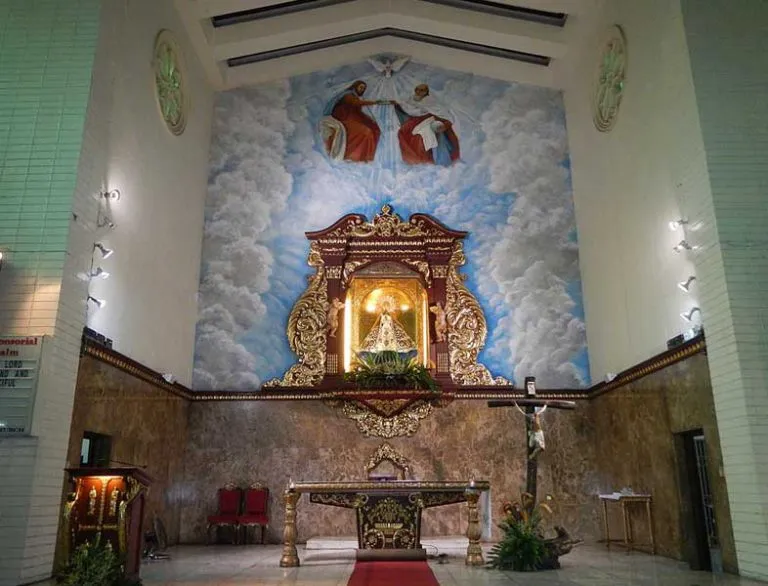
Coronation
The Marian image was episcopally crowned on Rizal Day, 30 December 1955 by the Apostolic Nuncio to the Philippines, Archbishop Egidio Vagnozzi.
The statue was removed from the shrine and placed in the room of Pope John Paul II for the duration of his visit in early January 1995 for World Youth Day.
On 14 January 2015, the image was again removed from Ermita Church and translated to the Apostolic Nunciature along Taft Avenue, where Pope Francis stayed during his visit to the Philippines and Sri Lanka. The icon was later present at Quirino Grandstand for the Pope’s open-air Mass on 18 January.
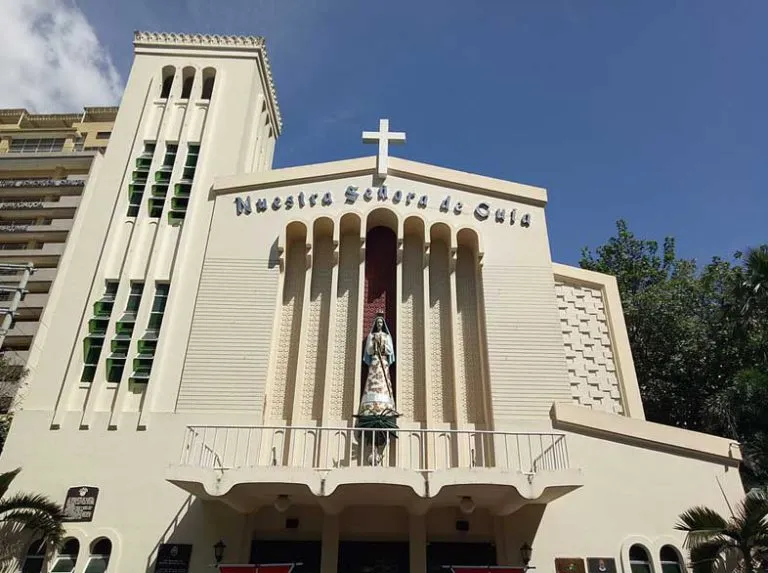
Archdiocesan Shrine
The church was granted archdiocesan shrine status in 2005 under former Archbishop of Manila Cardinal Gaudencio Rosales. The current parish priest and rector is the Reverend Monsignor Mario David Enríquez, who was installed on 16 July 2015.
Patronage
Due to the church’s proximity to the United States Embassy, the statue is often visited by locals who petition the Virgin for safety in overseas travel. Devotees claim that when invoked under this title, the Virgin’s intercession is speedy and miraculous, particularly in securing approval of requests for United States visas.
She is also considered the patroness of all Overseas Filipino Workers.
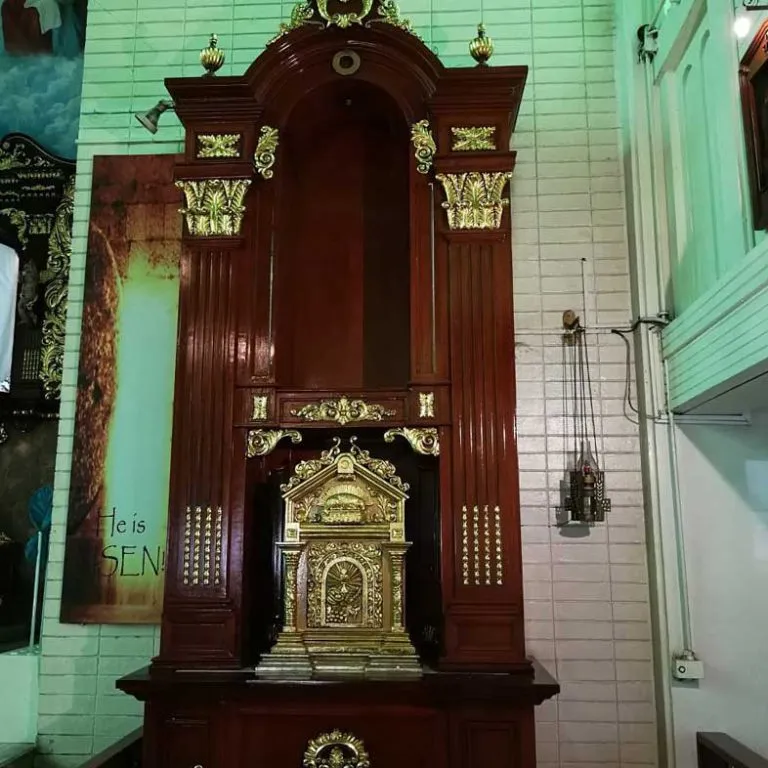
Feast Day - 19th May
It was erected right on the site where the image of Our Lady was found on May 19, 1571, making it the oldest among all those venerated in the Philippines. In 1578, the king of Spain, in a royal decree, declared Our Lady of Guidance as the “sworn patroness” of Manila.
The original feast day of the image was kept on 18 December, but the date was transferred to 19 May when a rainstorm hit Manila Cathedral in February 1771.
Feast Day of Our Lady of Guidance held on 19th May.
Mass Time
Weekdays
Sundays
Church Visiting Time
Contact Info
Flores, Ermita, Manila,
1000 Metro Manila, Philippines.
Phone No.
Tel : +63 2 8523 2754
Accommodations
How to reach the Shrine
Ninoy Aquino International Airport also known as Manila International Airport located in Manila, Philippines is the nearby Airport to the Shrine.
Central Terminal (Manila Light Rail Station) in Manila, Philippines is the nearby Train Station to the Shrine.

